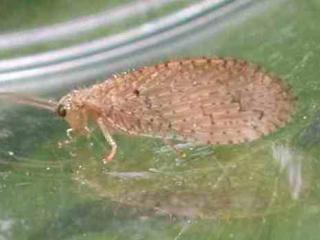What predators look like
- Hoverfly larvae feed on aphids
- Hoverfly adults are more likely to be seen in crops
- Lacewing larvae and adults feed on aphids
What parasitic wasps look like
These are wasp species, which sting the aphids and lay an egg inside. The larvae hatches and slowly consumes the aphid, eventually killing it. The parasite larva creates a ‘mummy’ by spinning a cocoon inside the aphid, then pupates and soon emerges as an adult wasp. The presence of bloated aphids with a pale gold or bronze sheen indicates parasite activity in your canola crop.
Threshold for aphids
If more than 20% of plants are infested with colonies of aphids, control measures should be considered to avoid yield losses.
Factors that increase the risk of economic yield losses are poor finishing rains or crops already under some degree of drought stress.
Encourage beneficials
Predators and parasites should be encouraged as a natural way of suppressing aphid numbers. This can be achieved by using ‘softer’ chemicals (such as pirimicarb) which are aphid-specific and less harmful to other insects.
Cultural controls
Implement early control of weeds such as wild radish and wild turnip on your property to prevent aphid build up. Sow crops early to enable plants to begin flowering before aphid numbers peak.
Chemical control
Pirimicarb and sulfoxaflor are currently registered for aphid control in canola crops in this state. Check with the Australian Pesticides and Veterinary Medicines Authority (APVMA) for any off-label permits each growing season.
Green peach aphids and resistance
Large numbers of green peach aphids occasionally occur on young, vegetative canola, which may require treatment; some of these populations are resistant to some chemicals.
Synthetic pyrethroids (SPs) and some organophosphates (OPs) have given poor kill results when applied to aphid-infested canola. Often the crop needs to be resprayed after SP application, which achieves less than optimum kill rates. Avoid using SPs for this reason and also because this chemical group selects for insecticide resistance and kills non-target organisms including beneficial insects. For more information refer to Grains Research and Development Corporation's Green peach aphid management strategy.
Acknowledgements
Grains Research and Development Corporation for provided funding for aphid research trials.




